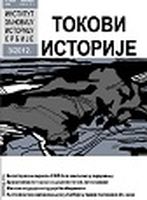Komparativna analiza јugoslovensko-turske Konvencije iz 1938. i„džentlmenskog sporazuma“ iz 1953. Pregovori oko iseljavanja muslimana iz Jugoslavije
Comparative Analysis Of 1938 Yugoslav-Turkish Convention And The 1953 „Gentlemen’s Agreement“. Negotiations On The Migration Of Yugoslav Muslims To Tu
Author(s): Edvin PezoSubject(s): History
Published by: Institut za noviju istoriju Srbije
Keywords: Milan Stojadinović; Yugoslav-Turkish Convention (1938); ”Gentlemen’s Agreement” (1953); interministerial conference (1935); citizenship law (1928, §55); state repression; Turkish immigration policy
Summary/Abstract: When comparing the genesis and contents of the 1938 Yugoslav-Turkish Convention with the 1953 ”Gentlemen’s Agreement” it can be concluded that there was a certain similarity but no continuous policy of Muslim population migration from Yugoslavia to Turkey. The role of the Yugoslav government regarding this issue greatly changed when we compare the thirties and fifties. During the thirties the government in Belgrade mostly due to geopolitical reasons endorsed a planned migration of non Slav Muslims, mostly Albanians. The government headed by Milan Stojadinović, who was the initiating force behind the process, endorsed a joint agreement with Turkey. Furthermore, repressive measure were also undertaken to encourage migration and create a right atmosphere for it. That was not the case in the fifties when Turkey was the initiator for a joint agreement that was to enable the migration of ”Turks” to Turkey. The initiative and request this time came from Turkey. The Yugoslav side took a passive attitude at that time and obliged Turkey on the issue by limiting migration of the non Turkish population. All in all, the fifties agreement had a completely different character then the one from the thirties where etnopolitical dimensions dominated. Differences can be seen on the issue of repression, that is, focused use of violence by the state. Repressive measure overlapped with the negotiations of the governing structures on the convention while similar repressive measures against the emigrating Muslim population did not exist in the fifties. The only incidents that could possible fit into this context are the events that took place at Kosovo in the winter of 1955/56. At that time a campaign was conducted to collect weapons from the population, however a scholarly study on the course and dynamics of these events is still lacking. What is known is that violence was used to a great extent on that occasion and it resulted in the probable death of a several tens of people. These events surely influenced parts of the Kosovo population to migrate to Turkey via Macedonia. But in the author’s opinion these events cannot be directly connected with a certain planned action for a forced migration of Albanians. If the state had such intentions it would have created the necessary administrative conditions as was the case in the thirties. The authorities would at least have allowed or made easier the migration of the Albanian population from Kosovo, which was not the case.
Journal: Tokovi istorije
- Issue Year: 2013
- Issue No: 2
- Page Range: 97-120
- Page Count: 24
- Language: Serbian

